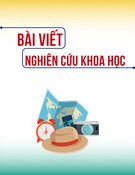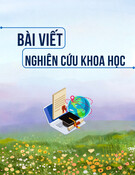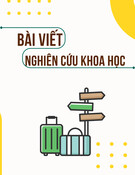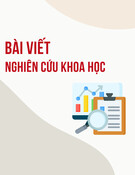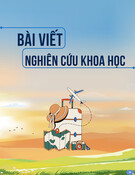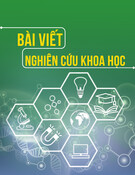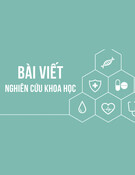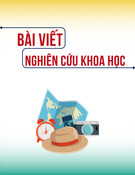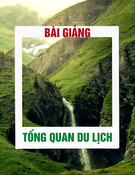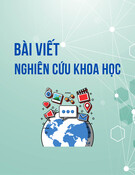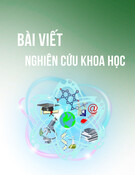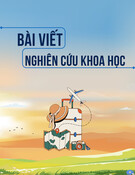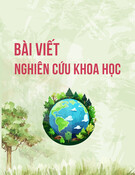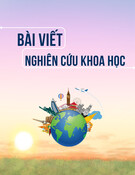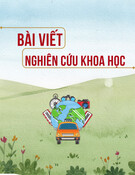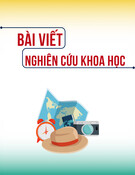
T
ẠP CHÍ KHOA HỌC
TRƯ
ỜNG ĐẠI HỌC SƯ PHẠM TP HỒ CHÍ MINH
Tập 22, Số 4 (2025): 699-711
HO CHI MINH CITY UNIVERSITY OF EDUCATION
JOURNAL OF SCIENCE
Vol. 22, No. 4 (2025): 699-711
ISSN:
2734-9918
Websit
e: https://journal.hcmue.edu.vn https://doi.org/10.54607/hcmue.js.22.4.4570(2025)
699
Research Article1
EDUCATIONAL SOLUTIONS TO STRENGTHEN THE POSITIVE
IMPACT OF COMMUNITY-BASED TOURISM ON THE ECONOMIC
ASPECT: A CASE STUDY OF CON CHIM, TRA VINH PROVINCE
Tran Dinh Khang
University of Social Sciences and Humanities, Vietnam National University, Ho Chi Minh City, Vietnam
Corresponding author: Tran Dinh Khang – Email: khangtd00@gmail.com
Received: October 29, 2024; Revised: November 05, 2024; Accepted: March 28, 2025
ABSTRACT
This article gathers information to clarify the positive economic impacts of community-based
tourism, along with the advantages and challenges involved in developing this type of tourism in Con
Chim, Tra Vinh province. The research findings indicate that the expansion of community-based
tourism in Con Chim has resulted in significant economic improvements, such as increased income
for local residents, the creation of more job opportunities, reduced dependence on agriculture, etc.
While the advantages are evident, some challenges must be addressed to ensure sustainable growth.
In addition, this development allows the local community to gain more knowledge, develop essential
skills, and enhance their overall well-being. Based on these findings, educational solutions are
suggested to further promote the positive effects of community-based tourism, supporting long-term
economic sustainability.
Keywords: Community-based tourism; Cồn Chim; economic growth; sustainable
development; Tra Vinh
1. Introduction
In recent years, research on tourism for poor communities has become increasingly
popular globally (Musavengane et al., 2019). There is considerable evidence worldwide
showing that tourism development has a strong impact on economic growth. In countries
where tourism activities are active, the economy grows (Pulido-Fernández & Cárdenas-
García, 2021). Economic growth is achieved through the expansion of tourism activities
(Cárdenas-García et al., 2015). As a result, it contributes to improving the living conditions
of the local people (Li et al., 2018). Tourism development helps reduce poverty and fosters
personal growth (Alcalá-Ordóñez et al., 2024; Jiang et al., 2011). The tourism industry
positively impacts human development by boosting per capita GDP (Sharma et al., 2020). It
Cite this article as: Tran, D. K. (2025). Educational solutions to strengthen the positive impact of community-
based tourism on the economic aspect: a case study of Con Chim, Tra Vinh Province. Ho Chi Minh City University
of Education Journal of Science, 22(4), 699-711. https://doi.org/10.54607/hcmue.js.22.4.4570(2025)

HCMUE Journal of Science
Tran Dinh Khang
700
creates job opportunities for workers (Chattopadhyay et al., 2022; Yakup, 2019) and helps
increase foreign exchange earnings. In Vietnam, studies have concluded that community-
based tourism development helps generate income and employment for local residents (Cao
& Nguyen, 2023; Tran & Ngo, 2024). Dang Trung Kien (2020) also argues that community
tourism development helps stimulate economic issues. Ta Duy Linh (2022) conducted a
study on the community tourism activities of Khmer households, and the results showed that
participation in the tourism sector improved their material life, while also enhancing their
awareness of ethnic and cultural values, creating cultural exchange opportunities, raising
public awareness, and strengthening social networks.
Since 2019, when tourism emerged as a viable livelihood in Con Chim, many studies
have explored its community tourism model. Ta Duy Linh et al. (2021) examined the factors
driving the development of the Con Chim community tourism model and its underlying
exploitation philosophy. Ho Tieu Bao and Hoang Ngoc Minh Chau (2021a) investigated
agricultural tourism development in Con Chim, contributing to the theoretical framework of
agricultural tourism destinations. In a subsequent study, Ho Tieu Bao and Hoang Ngoc Minh
Chau (2021b) analyzed the role of stakeholders in shaping and advancing agricultural
tourism in the region. Further, Ho Tieu Bao and Hoang Ngoc Minh Chau (2022) explored
sustainable tourism principles, encompassing economic, socio-cultural, and environmental
dimensions, in the context of Con Chim. Hoang Ngoc Minh Chau (2023) highlighted the
critical role of social capital in the tourism development process. However, among these
studies, only Ho Tieu Bao and Hoang Ngoc Minh Chau (2022) addressed the positive
economic impacts of community tourism in Con Chim, without proposing strategies to
amplify these benefits.
This study adopts a qualitative methodology to collect evidence elucidating the
positive economic impacts of community tourism in Con Chim, while also identifying the
facilitating factors and barriers to its development. The findings inform the proposal of
educational interventions aimed at amplifying these economic benefits and fostering
sustainable regional growth. The research addresses four key questions:
(1) What are the positive economic impacts of community tourism activities in Con Chim?
(2) What advantages enable the development of community tourism in Con Chim?
(3) What challenges impede the progress of community tourism in Con Chim?
(4) What educational strategies can be implemented to enhance the economic benefits
of community tourism activities in Con Chim?
2. Theoretical foundation and research methodology
2.1. Theoretical foundation
2.1.1. Educational solutions
An educational solution is considered comprehensive, creative, and flexible only when
it aligns with the social, economic, technological, and cultural conditions of the target

HCMUE Journal of Science
Vol. 22, No. 5 (2025): 699-711
701
audience (Badar & Mason, 2020). According to Selvaraj (2014), an educational solution may
be limited if it does not clarify the social relationship from the local context to broader
institutional aspects. The educational solution focuses on developing environmental ethics,
aiming to integrate nature and the mind by altering cognitive and sensory processes (Lavrysh
et al., 2020). It is built as a process rather than just an event, as learning is inherently a
journey with multiple stages, including preparation and practical learning (Nielsen et al.,
2019). Thus, it can be understood that an educational solution is a way to address problems
in a comprehensive, creative, and flexible manner, aimed at developing environmental ethics
and integrating nature with the mind while being in harmony with the economic, social,
technological, and cultural conditions of the recipients. It views learning as a continuous
journey with many stages, rather than merely isolated events.
2.1.2. Community-based tourism activities
Roy (2010) argues that diverse community-based tourism activities are an effective
mechanism for protecting natural resources and fostering communication with local
residents. Puspita and Nurhidayati (2018) note that this activity also helps mitigate the
negative impacts of tourists while enhancing benefits for the local population. According to
Yanes et al. (2019), community-based tourism is a project, program, or collective action by
the community aimed at developing small to medium-scale tourism. Moreover, Maldonado-
Erazo et al. (2023) emphasize that community participation in managing and operating
initiatives is a key element of this activity. Thus, community-based tourism can be defined
as a form of tourism in which local residents actively participate in the development and
management of tourism activities in their area. This type of tourism not only helps conserve
natural resources and local culture but also generates economic benefits for the community
by providing services such as accommodation, tour guides, and experiential activities.
Furthermore, the active participation of the community is a core factor that creates a
connection between tourists and residents while enhancing awareness and responsibility
towards their resources and culture.
2.2. Research methodology
2.2.1. Secondary data
Secondary data are pivotal to this study, with the researcher synthesizing information
from diverse, credible sources, including peer-reviewed journal articles, books, and
dissertations addressing the economic impacts of community-based tourism globally and within
Vietnam. Sources from esteemed publishers such as Taylor & Francis and Elsevier, alongside
reports from the United Nations World Tourism Organization (UNWTO) and the Vietnam
National Tourism Administration, provide insights directly relevant to the research objectives.
This analysis has deepened the understanding of the interplay between community-based
tourism and economic development, laying a robust foundation for the focused investigation of
Con Chim, Tra Vinh province. The insights derived inform the formulation of targeted
educational strategies to enhance economic benefits for the local community.

HCMUE Journal of Science
Tran Dinh Khang
702
2.2.2. Observation
Observation was also used to record the spatial conditions, landscape, infrastructure,
and the lives of local residents. This method facilitated the systematic recording of temporal
changes in these elements, providing direct, tangible evidence of the economic impacts of
community-based tourism. The observation method plays a crucial role in providing direct
and concrete evidence of the impacts of community-based tourism on the local economy. By
offering insights into the evolving physical and social environment, observation significantly
contributes to an understanding of tourism’s influence on the local economy.
2.2.3. Participatory observation
Participant observation was utilized in this study. The researcher engaged in tourism
services at Con Chim to assess the local community’s communication, interaction, and service
skills. This method is vital for capturing insights into the community’s competencies,
perceptions, and attitudes toward tourism. These observations enable a comprehensive analysis
of the economic impacts of community-based tourism in Con Chim, Tra Vinh province, and
inform the development of targeted educational solutions to enhance local economic benefits.
2.2.4. In-depth interview
In-depth interviews were also used to gather information from local residents directly
involved in community-based tourism activities. This method not only provides a better
understanding of the detailed experiences and perspectives of the community but also
clarifies the economic impacts that community-based tourism. After collecting the data in
audio form, the Memobot application was used to convert it into text.
3. Results and discussion
3.1. Positive Impacts of Community-Based Tourism Activities in Con Chim on Economic
Aspects Table 1. Participation in community-based tourism activities and services
No.
Household name
Tourism services
1
Sau Mai
Bicycle rental, crab fishing
2
Ms. Van
Southern Kitchen, homestay
3
Ms. Loan
West Lake cuisine
4
Thao
Coconut garden
5
Ms. Ba Sua
Stinky opal berry cake
6
Mr. Thanh
Folk games of Lang Toi
7
Nam Luong
Con Chim meal
8
Sau Giau
Vietnamese pancakes
9
Nam Lien
Water coconut
10
Tu Pha
Crab fishing, homestay
11
Ms. Meo
Don Ca Tai Tu (traditional music)
12
Ba Hau
Wild honey
13
Mr. Long
Homestay
14
Ms. Huong
Homestay

HCMUE Journal of Science
Vol. 22, No. 5 (2025): 699-711
703
As of July 2024, Con Chim has 54 households. Table 1 shows that 14 households are
directly involved in community tourism activities in Con Chim. Before tourism developed,
the locals mainly relied on agriculture, cultivating rice and raising shrimp seasonally, selling
products at low prices to middlemen. With the introduction of tourism, they began selling
shrimp and crabs to tourists at higher prices, and many households shifted from farming to
serving tourists, earning from 5 to 20 million VND per month from services such as food,
homestays, and folk games. Tourism has also created job opportunities for locals, helping to
increase income and reduce the pressure from middlemen. Households not directly involved
in tourism still benefit by supplying agricultural products to other households. After the
COVID-19 pandemic, although commodity prices rose, the prices of tourism services
remained unchanged, indicating that tourism has contributed to sustainable economic
development in Con Chim (Ho & Hoang, 2022).
During a recent visit to Con Chim, observations revealed positive shifts in the local
community’s perceptions and attitudes toward tourism activities. The economic benefits
derived from community-based tourism have significantly increased household incomes and
generated diverse employment opportunities, encouraging residents to actively engage in
tourism-related services, including food, accommodation, and entertainment. They now
have access to a larger market, where they can sell products at higher prices than before, thus
improving the living standards of many households. This increased income is not just a
financial boost but also a resource for them to invest in education and personal development,
creating a new generation with higher skills.
Since starting tourism, I feel much more excited. Suddenly, I, a country person, know how to do
tourism, and tourists from all over the world know about Con Chim, I really like it. I even
increased my income, earning 150 million VND a year. This is the truth. Also, the teachers say I
look younger than when I first started tourism. Thanks to that money, my children. (Mrs. V)
Furthermore, the development of the tourism industry has created many new job
opportunities. Diverse services have grown significantly, contributing to the creation of a
rich economic ecosystem, and encouraging career diversification and sustainable
development for the community. In the past, the people of Con Chim faced many difficulties
due to their dependence on agriculture, but now, by choosing to engage in tourism, they have
secured more stable incomes and improved their quality of life.
Before I started in tourism, the economy was very difficult and uncertain. After joining
tourism, the income has been relatively stable, although not much yet, but life is more stable.
Before tourism, the people here were simple, without much education or refined language.
Since joining the tourism community, I've learned from visitors from other provinces and also
from the teachers at the research institute. I've learned a lot about language, and behavior, and
from there, the community has improved their knowledge. Now, the people speak like cultured
individuals. I still remember when the first group of tourists arrived, everyone was shy, some
even ran away and didn’t dare to greet the tourists. (Mr. NL)





